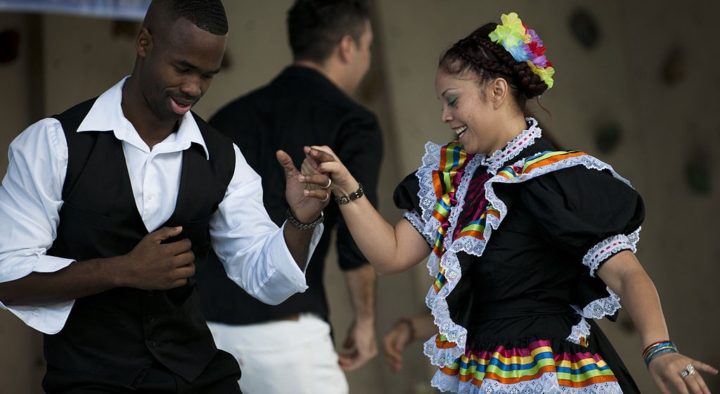By Arturo Ignacio Sánchez
In 1968 President Lyndon B. Johnson established Hispanic Heritage Month (HHM). The objective was to highlight Hispanic cultures and their contributions to the national landscape. HHM, in effect, was crafted as a top-down cultural policy to encourage ethnic incorporation, increase economic and political participation, and consolidate and expand the so-called “American Dream.”
Thirty-eight years have come and gone since HHM was launched as an inclusionary “ethnic” political project. Which brings to the fore a basic question: How has the HHM initiative been operationalized at the local level, and has it improved the life chances of diverse Latino communities and their residents?
Addressing this question is complicated by the historical, geographical, economic, and political differences that frame Latino marginalization. As such, since marginalization is experienced at the local everyday level, the discussion will revolve around the Latinized multi-cultural neighborhoods of Corona, Elmhurst and Jackson Heights in Queens County, New York.
.
Before proceeding, let’s establish the historical framework. HHM was a top-down strategic response to the racialize urban unrest and political disorder that defined the turbulent 1960s. On the domestic front, the “American Ethnic Creed” of inclusion, the viability of national institutions, and the notion of economic justice were under siege. The U.S., in short, was experiencing an institutional crisis.
The HHM was launched – in this context and with the backdrop of the Civil Rights Movement – as a symbolic tip-of-the-hat. The initiative bureaucratically recognized the cultural presence of Latinos, without reforming the mechanisms of systemic marginalization. It was a defensive maneuver that co-opted Latino movements of economic and political re-vindication. Political scientists call such defensive processes “system maintenance strategies.”
Fast-forward to Queens County in 2016. Once again national and local landscapes are under siege. Neoliberal economic restructuring, hyper-gentrification, unsustainable levels of income concentration, immigrant bashing, and the loss of viable employment opportunities have placed local neighborhoods and basic institutions at risk. Yet unlike the church-driven “center of gravity” that defined the African-American Civil Rights Movement, Latino ethnic communities lack meaningful bottom-up Pan Latino organizational networks to systematically and consistently confront longstanding marginalization. In effect, Latino differences are framed and balkanized by a complex mix of systemic marginalization, racialized demonization, linguistic isolation, undocumented status, impoverished ethnic institutions, national/class differences and group-based rivalries.
Nonetheless, initiatives connected to immigration reform and migrant social justice have triggered reactive bottom-up Latino political activity at the neighborhood level. Unfortunately, these political irruptions have been captured, molded and managed by self-serving nonprofits beholden to a local and citywide political regime intent on tinkering around the “pragmatic margins,” maintaining their political presence and waving the banner of ethnic symbolism. In short, so-called “political progressives” have tactically used Latino balkanization and seized “Hispanic cultural” practices to weave a narrative that “bangs the drum” for social justice, while minimizing fundamental economic and political change.
At the neighborhood level, residents of Corona, Elmhurst, and Jackson Heights have elected three Latinos to public office: Councilwoman Julissa Ferreras, State Assembly Senator Jose Peralta, and State Assemblyperson Francisco Moya. And as products of the existing political regime, these elected representatives have used “Hispanic” culture as a hall of mirrors that distorts and diverts efforts at meaningful change. In keeping with HHM, local electeds have invoked and duly celebrated the “soft” messages associated with “Hispanic culture. Clearly, displays of folklore and ethnic celebrations are important and should have a place on the public palate. But celebrating culture at the expense of “hard” economic and political issues is neither progressive nor useful when crafting social justice agendas.
Over the years, Latino elected officials have aggressively supported corporate privatization of Flushing Meadow Corona Park, marketization off Willets Point, and the establishment of the Roosevelt Avenue Business Improvement District. Their enthusiastic political support is couched in a narrow mainstream narrative of corporate economic growth, trickle-down economics, and quality-of-life concerns. In sum, these projects of economic mis-development are accelerating gentrification and the massive expulsion of Latino businesses and residents. The outcomes are weakened socio-economic ethnic landscapes and domesticated culture(s) that are easily hijacked in support of a politics of inequitable continuity.
The HHM cultural project is strategically misused by Latino electeds as a veil of celebratory ignorance. This cultural manipulation clouds and supports the forces that perpetuate various forms of Latino marginalization. Clearly, when power is in play, culture disconnected from its economic and political foundations is the line of least resistance.
_________________________________________
Arturo Ignacio Sánchez, Ph.D. is an urban planner and chairperson of the Newest New Yorkers Committee, Community Board 3, Queens. He has taught at Barnard College, City University of New York, Columbia University, Cornell University, New York University, Pratt Institute and various Latin American Universities.










